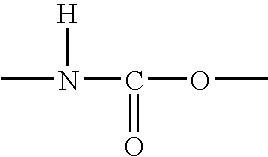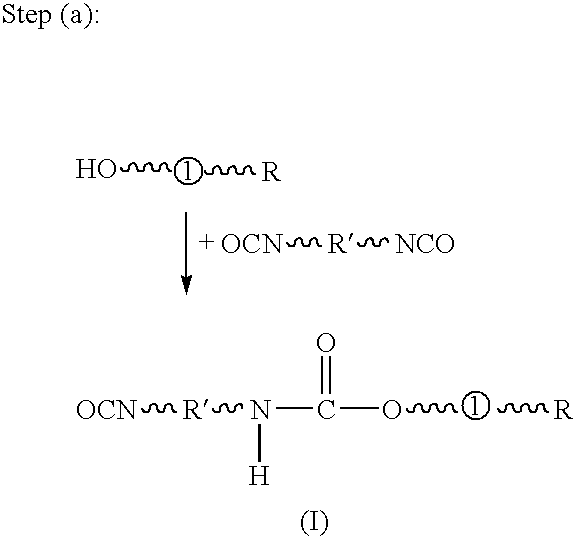Radiation-curable, solvent-free and printable precursor of an adhesive
a precursor, solvent-free technology, applied in the direction of adhesive types, applications, other domestic objects, etc., can solve the problems of increasing the difficulty of die-cutting of adhesive tape, increasing the difficulty of adhesive tape die-cutting, and inability to meet the requirements of many applications
- Summary
- Abstract
- Description
- Claims
- Application Information
AI Technical Summary
Benefits of technology
Problems solved by technology
Method used
Image
Examples
example 1
[0178] An adhesive precursor was prepared by combining the components shown for Example 1 in Table 1. The amounts of the mono- and di-acrylate functional oligomers, respectively given in Table 1, were calculated from the respective amounts of GENOMER 4188 or 4269. Likewise, the amounts of the monomer EHA and 2-acrylic acid 2-(((acryl-amino) carbonyl) oxy) ethylester (=GENOMER 1122) contained in GENOMER 4188 and 4269, respectively, are included in the respective amounts given for such monomers.
[0179] Adhesive precursor was applied to 175 μm polyester film using a knife-coater to give a thickness of 50 μm.
[0180] The adhesive precursor was first partially cured using UV dryer Natograph Ltd —UV Dryer, Type 90-0220-T8, available from Natograph Ltd., Nothingham, UK, commonly employed for drying and curing of screen-printing inks. The polyester film, available as Melinex ST 726 from DuPont, was primed with an acrylate primer on both sides and used as received. The amount of energy incide...
examples 2-5
[0184] Examples 2-5 were prepared and tested in the same manner as Example 1. The compositions of the adhesive precursors of Examples 2-5 are shown in Table 1. Higher levels of acryloylmorpholine (ACMO) were present (Ex. 2, 3 and 5) as well as substantial amounts of difunctional polyester urethane acrylate oligomer (Ex. 4 and 5). The amounts of the mono- and di-acrylate functional oligomers, respectively given in Table 1, were calculated from the respective amounts of GENOMER 4188 or 4269. Likewise, the amounts of the monomer EHA and 2-acrylic acid 2-(((acryl-amino) carbonyl) oxy) ethylester (=GENOMER 1122) contained in GENOMER 4188 and 4269, respectively, are included in the respective amounts given for such monomers.
[0185] The adhesive bond formed between two substrates was tested by the methods shown under Test Methods above. Results of the tests are shown in Table 2. Shear Adhesion Failure Tests on Examples 2-5 resulted in values all over 100° C.
[0186] In separate experiments,...
PUM
| Property | Measurement | Unit |
|---|---|---|
| Tg | aaaaa | aaaaa |
| dynamic viscosity | aaaaa | aaaaa |
| glass transition temperature | aaaaa | aaaaa |
Abstract
Description
Claims
Application Information
 Login to View More
Login to View More - R&D
- Intellectual Property
- Life Sciences
- Materials
- Tech Scout
- Unparalleled Data Quality
- Higher Quality Content
- 60% Fewer Hallucinations
Browse by: Latest US Patents, China's latest patents, Technical Efficacy Thesaurus, Application Domain, Technology Topic, Popular Technical Reports.
© 2025 PatSnap. All rights reserved.Legal|Privacy policy|Modern Slavery Act Transparency Statement|Sitemap|About US| Contact US: help@patsnap.com



